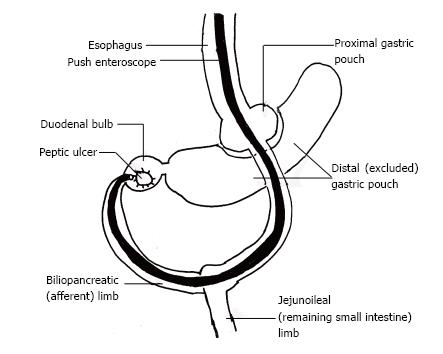Copyright
©The Author(s) 2017.
World J Gastrointest Endosc. Oct 16, 2017; 9(10): 521-528
Published online Oct 16, 2017. doi: 10.4253/wjge.v9.i10.521
Published online Oct 16, 2017. doi: 10.4253/wjge.v9.i10.521
Figure 3 Sketch showing coronal axis of upper gastrointestinal tract during intubation of afferent (biliopancreatic) limb using a push enteroscope in a patient status post Roux-en-Y gastric bypass for morbid obesity.
After Roux-en-Y gastric bypass (RYGP) direct continuity between the proximal and distal stomach is severed and the stomach is surgically divided and reconstructed to form two pouches: A small proximal gastric pouch that connects directly to the proximal jejunum via a surgical anastomosis (efferent limb) and a large distal pouch that connects retrograde only to the duodenum via the duodenal bulb (afferent limb). Surgical reconstruction of a small proximal gastric pouch promotes weight loss by causing early satiety due to limited proximal gastric pouch capacity, and by causing decreased appetite by reducing ghrelin synthesis. The sketch shows that the afferent (biliopancreatic) limb is hard to reach and intubate using a routine esophagogastroduodenoscope after RYGP because of the long distance traversed (through the jejunum) to reach the afferent limb, and sharp angulation at the anastomosis between the afferent and efferent limbs. Failure to intubate the afferent limb results in missing lesions in this limb, as occurred in the 2 currently reported cases in which duodenal bulb ulcers with high risk stigmata of recent hemorrhage were missed.
- Citation: Hakim S, Reddy SRR, Batke M, Polidori G, Cappell MS. Two case reports of acute upper gastrointestinal bleeding from duodenal ulcers after Roux-en-Y gastric bypass surgery: Endoscopic diagnosis and therapy by single balloon or push enteroscopy after missed diagnosis by standard esophagogastroduodenoscopy. World J Gastrointest Endosc 2017; 9(10): 521-528
- URL: https://www.wjgnet.com/1948-5190/full/v9/i10/521.htm
- DOI: https://dx.doi.org/10.4253/wjge.v9.i10.521









